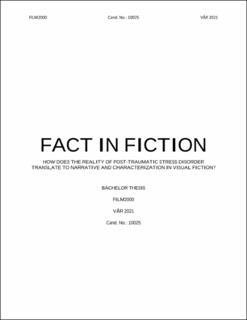| dc.contributor.advisor | Bakøy, Eva | |
| dc.contributor.author | Torseth, Bjørn Vegar | |
| dc.date.accessioned | 2021-09-14T16:14:22Z | |
| dc.date.available | 2021-09-14T16:14:22Z | |
| dc.date.issued | 2021 | |
| dc.identifier | no.ntnu:inspera:76749986:35080610 | |
| dc.identifier.uri | https://hdl.handle.net/11250/2776666 | |
| dc.description.abstract | Mentale lidelser er ofte bruke for karakterisering og narrative formål, ofte for å motivere skurken slik at deres virkelighetsfjerne mål og handlinger har en anelse troverdighet. Dette kan lede til demoniseringen av noen mentale lidelser og spre misledende informasjon om de lidelsene til publikum gjennom misrepresenterende fremstillinger. Når man ser på hvordan Posttraumatisk stresslidelse fremstilles, er karakterene oftest protagonisten i historien. Siden publikum vanligvis skal heie på protagonisten, har dette en påvirkning på fremstillingen av den mentale lidelsen? Kort sagt, hvordan blir posttraumatisk stresslidelse portrettert, negativt eller positivt, i visuell narrativ fiksjon?
For å undersøke dette ser jeg på årsakene og symptomene til PTSD, og analyserer dem i forhold til deres narrative funksjon, og analyserer så videre flere filmer for å se hvordan de brukes i praksis. Resultatet av min analyse er a PTSD er en mental lidelse som, i kontrast til de mange andre lidelsene som blir brukt i narrativ fiksjon for å motivere skurker, er velpassende for historiens protagonist. Årsakene og lidelsene har iboende karakteristikker som skaper sympati for karakteren, passer godt til etablerte narrative strukturer som tre-aktsstrukturen, som gjør at den er mer rettferdig portrettert en andre mentale lidelser brukt i visuell narrativ fiksjon. | |
| dc.description.abstract | Mental illness is often used for characterization and narrative purposes, often to motivate villains so that their frequently far-fetched objectives and actions have some semblance of plausibility. This may, in turn, lead to the demonization of certain mental illnesses, and spread misleading information about that illness to the public through misrepresentation in its portrayal. Looking at portrayals of Post-Traumatic Stress Disorder, these characters seem to most often be the protagonist of the story. As an audience is generally supposed to root for the protagonist, does this have an effect on the portrayal of that mental illness? In short, how is Post-Traumatic Stress Disorder used or abused in visual narrative fiction?
To explore this question, I look at the causes for, and symptoms of, PTSD, and analyze them in regard to their narrative functions, and then analyze several films to see how they are used in practice. The result of my analysis is that PTSD is a mental illness that, in contrast to the many others used in narrative fiction to motivate villains, is well-suited for the protagonist of the story. Its causes and symptoms inherently establish sympathy for the character, fits well with established narrative structures like the three-act structure, and that in being primarily used for the protagonist, is far more fairly portrayed than other mental illnesses used in visual narrative fiction. | |
| dc.language | eng | |
| dc.publisher | NTNU | |
| dc.title | FACT IN FICTION: HOW DOES THE REALITY OF POST-TRAUMATIC STRESS DISORDER TRANSLATE TO NARRATIVE AND CHARACTERIZATION IN VISUAL FICTION? | |
| dc.type | Bachelor thesis | |
